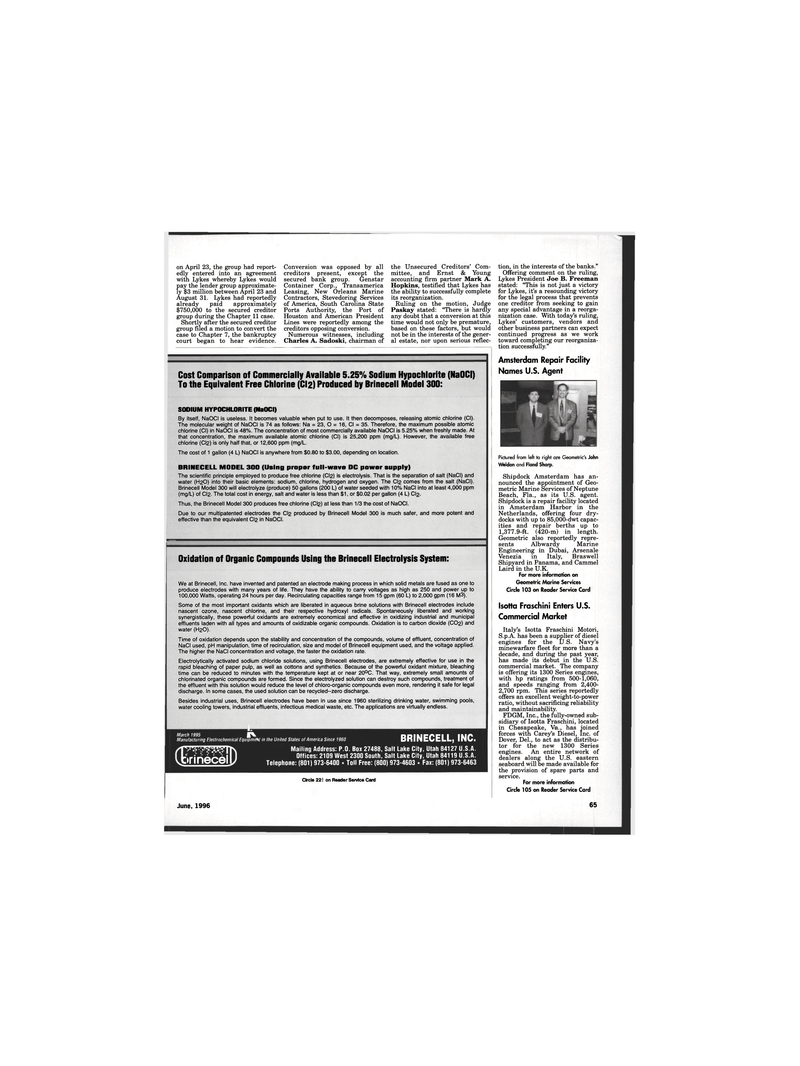
Page 63: of Maritime Reporter Magazine (June 1996)
Read this page in Pdf, Flash or Html5 edition of June 1996 Maritime Reporter Magazine
on April 23, the group had report- edly entered into an agreement with Lykes whereby Lykes would pay the lender group approximate- ly $3 million between April 23 and
August 31. Lykes had reportedly already paid approximately $750,000 to the secured creditor group during the Chapter 11 case.
Shortly after the secured creditor group filed a motion to convert the case to Chapter 7, the bankruptcy court began to hear evidence.
Conversion was opposed by all creditors present, except the secured bank group. Genstar
Container Corp., Transamerica
Leasing, New Orleans Marine
Contractors, Stevedoring Services of America, South Carolina State
Ports Authority, the Port of
Houston and American President
Lines were reportedly among the creditors opposing conversion.
Numerous witnesses, including
Charles A. Sadoski, chairman of the Unsecured Creditors' Com- mittee, and Ernst & Young accounting firm partner Mark A.
Hopkins, testified that Lykes has the ability to successfully complete its reorganization.
Ruling on the motion, Judge
Paskay stated: "There is hardly any doubt that a conversion at this time would not only be premature, based on these factors, but would not be in the interests of the gener- al estate, nor upon serious reflec-
Cost Comparison of Commercially Available 5.25% Sodium Hypochlorite (NaOCI)
To the Equivalent Free Chlorine (Cl2) Produced by Brinecell Model 300:
SODIUM HYPOCHLORITE (NaOCI)
By itself, NaOCI is useless. It becomes valuable when put to use. It then decomposes, releasing atomic chlorine (CI).
The molecular weight of NaOCI is 74 as follows: Na = 23, O = 16, CI = 35. Therefore, the maximum possible atomic chlorine (CI) in NaOCI is 48%. The concentration of most commercially available NaOCI is 5.25% when freshly made. At that concentration, the maximum available atomic chlorine (CI) is 25,200 ppm (mg/L). However, the available free chlorine (Cl2) is only half that, or 12,600 ppm (mg/L.
The cost of 1 gallon (4 L) NaOCI is anywhere from $0.80 to $3.00, depending on location.
BRINECELL MODEL 300 (Using proper full-wave DC power supply)
The scientific principle employed to produce free chlorine (Cl2) is electrolysis. That is the separation of salt (NaCI) and water (H2O) into their basic elements: sodium, chlorine, hydrogen and oxygen. The CI2 comes from the salt (NaCI).
Brinecell Model 300 will electrolyze (produce) 50 gallons (200 L) of water seeded with 10% NaCI into at least 4,000 ppm (mg/L) of Cl2- The total cost in energy, salt and water is less than $1, or $0.02 per gallon (4 L) Cl2-
Thus, the Brinecell Model 300 produces free chlorine (CI2) at less than 1/3 the cost of NaOCI.
Due to our multipatented electrodes the CI2 produced by Brinecell Model 300 is much safer, and more potent and effective than the equivalent CI2 in NaOCI.
Oxidation of Organic Compounds Using the Brinecell Electrolysis System:
We at Brinecell, Inc. have invented and patented an electrode making process in which solid metals are fused as one to produce electrodes with many years of life. They have the ability to carry voltages as high as 250 and power up to 100,000 Watts, operating 24 hours per day. Recirculating capacities range from 15 gpm (60 L) to 2,000 gpm (16 M3).
Some of the most important oxidants which are liberated in aqueous brine solutions with Brinecell electrodes include nascent ozone, nascent chlorine, and their respective hydroxyl radicals. Spontaneously liberated and working synergistically, these powerful oxidants are extremely economical and effective in oxidizing industrial and municipal effluents laden with all types and amounts of oxidizable organic compounds. Oxidation is to carbon dioxide (CO2) and water (H2O).
Time of oxidation depends upon the stability and concentration of the compounds, volume of effluent, concentration of
NaCI used, pH manipulation, time of recirculation, size and model of Brinecell equipment used, and the voltage applied.
The higher the NaCI concentration and voltage, the faster the oxidation rate.
Electrolytically activated sodium chloride solutions, using Brinecell electrodes, are extremely effective for use in the rapid bleaching of paper pulp, as well as cottons and synthetics. Because of the powerful oxidant mixture, bleaching time can be reduced to minutes with the temperature kept at or near 20°C. That way, extremely small amounts of chlorinated organic compounds are formed. Since the electrolyzed solution can destroy such compounds, treatment of the effluent with this solution would reduce the level of chloro-organic compounds even more, rendering it safe for legal discharge. In some cases, the used solution can be recycled-zero discharge.
Besides industrial uses, Brinecell electrodes have been in use since 1960 sterilizing drinking water, swimming pools, water cooling towers, industrial effluents, infectious medical waste, etc. The applications are virtually endless.
March 1995 (V
Manufacturing Electrochemical EquipmeH] In the United States of America Since 1960 >rinecel 1 the United States of America Since 1960 BRINECELL, INC.
Mailing Address: P.O. Box 27488, Salt Lake City, Utah 84127 U.S.A.
Offices: 2109 West 2300 South, Salt Lake City, Utah 84119 U.S.A.
Telephone: (801) 973-6400 * Toll Free: (800) 973-4603 * Fax: (801) 973-6463
Circle 226 on Reader Service Card tion, in the interests of the banks."
Offering comment on the ruling,
Lykes President Joe B. Freeman stated: "This is not just a victory for Lykes, it's a resounding victory for the legal process that prevents one creditor from seeking to gain any special advantage in a reorga- nization case. With today's ruling,
Lykes' customers, vendors and other business partners can expect continued progress as we work toward completing our reorganiza- tion successfully."
Amsterdam Repair Facility
Names U.S. Agent
Pictured from left to right are Geometric's John
Weldon and Fland Sharp.
Shipdock Amsterdam has an- nounced the appointment of Geo- metric Marine Services of Neptune
Beach, Fla., as its LJ.S. agent.
Shipdock is a repair facility located in Amsterdam Harbor in the
Netherlands, offering four dry- docks with up to 85,000-dwt capac- ities and repair berths up to 1,377.9-ft. (420-m) in length.
Geometric also reportedly repre- sents Albwardy Marine
Engineering in Dubai, Arsenale
Venezia in Italy, Braswell
Shipyard in Panama, and Cammel
Laird in the U.K.
For more information on
Geometric Marine Services
Circle 103 on Reader Service Card
Isotta Fraschini Enters U.S.
Commercial Market
Italy's Isotta Fraschini Motori,
S.p.A. has been a supplier of diesel engines for the IJ.S. Navy's minewarfare fleet for more than a decade, and during the past year, has made its debut in the U.S. commercial market. The company is offering its 1300 Series engines, with hp ratings from 500-1,060, and speeds ranging from 2,400- 2,700 rpm. This series reportedly offers an excellent weight-to-power ratio, without sacrificing reliability and maintainability.
FDGM, Inc., the fully-owned sub- sidiary of Isotta Fraschini, located in Chesapeake, Va., has joined forces with Carey's Diesel, Inc. of
Dover, Del., to act as the distribu- tor for the new 1300 Series engines. An entire network of dealers along the U.S. eastern seaboard will be made available for the provision of spare parts and service.
For more information
Circle 105 on Reader Service Card
June, 1996 65

 62
62

 64
64
